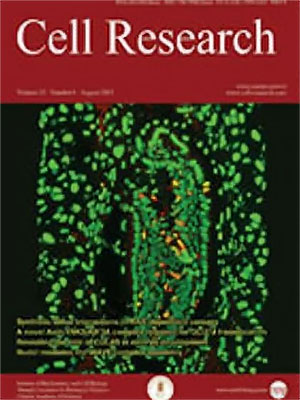
Volume 14, No 5, Oct 2004
ISSN: 1001-0602
EISSN: 1748-7838 2018
impact factor 17.848*
(Clarivate Analytics, 2019)
Volume 14 Issue 5, October 2004: 423-433
ORIGINAL ARTICLES
The expression of core fucosylated E-cadherin in cancer cells and lung cancer patients: prognostic implications
Fei GENG1, Bi Zhi SHI 1, Yun Feng YUAN2, Xing Zhong WU1*
1Department of Biochemistry and Molecular Biology, Fudan University Medical Center, Shanghai 200032, China
2Department of Thoracic Surgery, Zhongshan Hospital, Fudan University, Shanghai 200032, China
Correspondence: Xing Zhong WU(xz-wu@shmu.edu.cn)
It is well documented that the glycosylation of E-cadherin is correlated with cancer metastasis, but whether E-cadherin could be core fucosylated remains largely unknown. We found that E-cadherin was core fucosylated in highly metastatic lung cancer cells while absent in lowly metastatic lung cancer cells. Since α-1,6 Fucosyltransferase (α-1,6 FucT) is known to catalyze the reaction of core fucosylation, we investigated the biological function of core fucosylation on E-cadherin by α-1,6 FucT targeted RNAi and transfecting α-1,6 FucT expression vector. As a result, calcium dependent cell-cell adhesion mediated by E-cadherin was strengthened with the reduction of core fucosylation on E-cadherin after RNAi and was weakened with the elevated core fucosylation on E-cadherin after α-1,6 FucT over expression. Our data indicated that α-1,6 FucT could regulate E-cadherin mediated cell adhesion and thus play an important role in cancer development and progression. Computer modeling showed that core fucosylation on E-cadherin could significantly impair three-dimensional conformation of N-glycan on E-cadherin and produce conformational asymmetry so as to suppress the function of E-cadherin. Furthermore, the relationship between the expression of core fucosylated E-cadherin and clinicopathological background of lung cancer patients was explored in lung cancer tissue of patients. It turns out to demonstrate that core fucosylated E-cadherin could serve as a promising prognostic indicator for lung cancer patients.
FULL TEXT | PDF
Browse 1891


